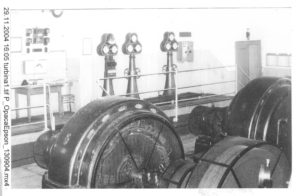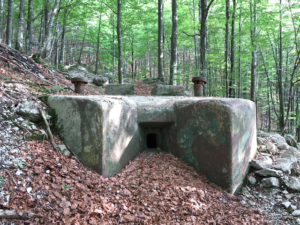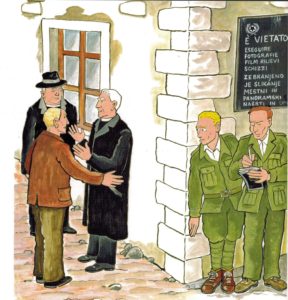On the museum’s ground floor there are some interesting objects, for example a grinding machine that could be put on the shoulder.
Room 4

On the museum’s ground floor there are some interesting objects, for example a grinding machine that could be put on the shoulder.

This object is a wooden box shaped like a parallelepiped. It contains a shelf for tools and personal belongings, a grind for sharpening connected to a transmission system, a support surface, and a container for the water that was used to wet the grind. The object also has two leather suspenders inserted in specific holes in the box that allowed its transportation. The grind’s rotation was activated through an impulse that the pedals transmitted to the piston rod and then to the traction wheel. The big wheel then moved the grind through a transmission belt.

There is also a wooden support for the work table, with grooves at different heights. A support was fastened to them with an iron rebar, and during the woodworking process the wood was placed on it.
The paper documents

The showcase with a drawer contains some paper documents.
Among them it is worth noticing a composition’s manuscript by monsignor Ivan Trinko from Tercimonte, in the Municipality of Savogna (1863-1954). He had a great influence in the cultural, artistic, historical, and political field, and was, for over half a century, a teacher, guide, and role model for all the priests working for the Slovene community in the Province of Udine. Slovene priests were very active in defending the use of the Slovene language during liturgical celebrations, in spite of the hostility that the political and ecclesiastical authorities had been showing to them after Italy annexed the Slavia valleys in 1866.

Italy namely started a process of flattening and assimilating these populations’ culture. The newspaper Il Giornale di Udine from 22nd November 1866 reports that: “These Slavs have to be eliminated with wealth, progress, and civilisation. (…) We are going to use the language and culture of the predominant society, which is Italian, to Italianise the Slavs in Italy (…)”. Since 1870 the Slovene language disappeared from religious rites in the churches of Lusevera and Villanoca. The school was given the task of assimilating their culture. Apart from this, the State showed a complete disinterest in these people’s hardships. A striking example of this lack of consideration for the valley’s community was the hydroelectric power station in Vedronza. It started providing energy to Udine’s tramway network in 1908, but electric energy first arrived to Vedronza’s houses in 1919, and took as long as until 1958 to get to Musi!


After the end of the Second World War, the Upper Torre Valley also had to withstand the presence of the border with Yugoslavia (which needed to be guarded in order to prevent attacks coming from the communist East), and became, for the most part, a militarised area with the presence of barracks, bunkers, military easement, and a firing range located along the road leading to the Tanamea Pass, which had to be closed frequently to allow the various units of the army to have their trainings in the area. Every time this happened, a red flag was lifted above the bell tower in Musi to warn the inhabitants and prevent them from getting scared by the loud blasts or coming close to the training area. Furthermore, for years a secret organisation working directly for the Italian State was at work on this territory to try and uproot the Slovene community, oppressing priests, teachers, and intellectuals who started claiming the cultural and linguistic rights of this population: communism was associated with the Slovene language spoken by the populations of Eastern Friuli, with the sole result that even more hatred was fostered towards them, thus persecuting a population that had already suffered from poverty and emigration.

The showcase displays some copies of the weekly newspaper “Matajur”, founded in 1950, and the bi-weekly “Dom”, founded in 1966, which were printed by the Slovene community and supported the cultural renaissance of the Slavia region.
Multimedia

The multimedia installation presents videos regarding the terrible earthquake that happened on 6th May 1976.

In the last room of the musem it is possible to watch a documentary realised by the Slovene RAI from Trieste on the numerous emigrants from the Natisone and Torre Valleys, who, at the end of the Second World War, were forced by poverty to leave their villages and look for work in Belgian coal mines.